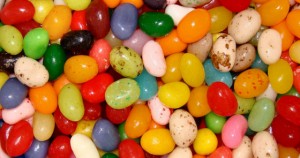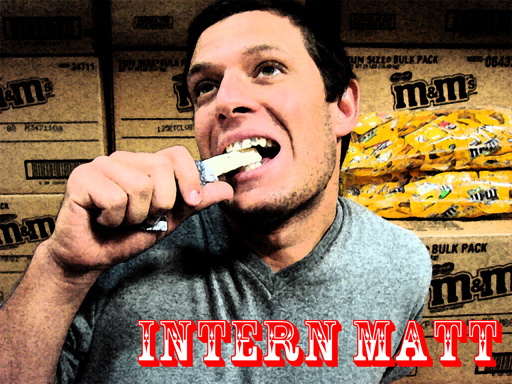Short Introduction
For those of you that don’t know, a jelly bean is more or less exactly what it sounds like. It is a bean-shaped candy with a semi-hard outer shell and a soft inside. They are generally fruit flavored, such as cherry and watermelon, but as production techniques have become more refined, companies have been able to experiment with many unique and interesting flavors, such as cotton candy and buttered popcorn. This candy has blossomed from an Easter-centered candy to a year-round favorite. Companies have the ability to change the colors and flavors of the jelly bean to match any occasion or season; red, white, and blue for the Fourth of July or orange and black for Halloween.
History
The exact date that jelly beans were created is unknown, but many believe they got their start during the civil war. In 1861, a man by the name of William Schraft began manufacturing jelly beans in Boston and encouraged people to send them to the soldiers to eat as snacks during the war. Some experts believe that the jelly center is descendent of a mid-Eastern confection known as Turkish Delight, which dates back to the biblical times.
However it was not until 1905 when the Chicago Daily News first mentioned jelly beans in an advertisement. Back then they sold for 9 cents per pound, and are considered to be the first “bulk candy.” Most historians have agreed that they were first linked with Easter in the 1930s.
In 1976, the Herman Goelitz Candy Co.,Inc. invented the gourmet jelly bean, which sprung new life into the jelly bean and assured it would last as a candy favorite.
Fun Fact: Jelly beans were Ronald Reagan’s favorite candy, thus during the Reagan administration, jelly beans could always be found in the White House. Reagan even had a specially made jelly bean holder for Air Force One so the jelly beans would not spill during turbulence. Jelly beans have also visited outer space when they traveled on the space shuttle.
Ingredients, Shape, Flavors
Although there are slight differences in the manufacturing processes between companies, the overall process required to make jelly beans is essentially the same.
The basic ingredients needed are sugar, corn syrup, and food starch. In addition to these ingredients, there are small proportions of flavoring that depend on the type of jelly bean. These natural and artificial flavors depend of the specific flavor and may include chocolate, coconut, peanuts, vanilla, oils, cream, or freeze-dried egg, milk, or fruit powders.
One of the recent advancements that has allowed for more creatively flavored jelly beans is the ability to have a particular jelly bean resemble its real world flavor. For example, a watermelon-flavored jelly bean has a soft red center and an outer green shell, so that it looks like a real watermelon. There is also a mixed fruit jelly bean, often known as tutti-frutti, that may have a soft pink center and a speckled outer shell, which suggests that it is a mixed flavor.
Believe it or not, the shape of the jelly bean remained relatively unchanged up until the mid-1970s when producers began manufacturing “gourmet” jelly beans. Gourmet jelly beans are typically smaller and softer than the traditional jelly beans. Since the introduction of gourmet jelly beans, manufacturers have been constantly changing the flavors available. They have been varying the flavors and colors that are available, replacing the less popular flavors with newly designed ones. Even creating fat-free jelly beans to adapt to a more health conscious generation.
The Manufacturing Process
This site has good pictures: https://wikis.nyu.edu/xdesign/mediawiki/index.php/Jelly_Bean
The manufacturing process begins far earlier than the actual creating of the jelly bean. It begins in a laboratory where chemists test new flavors and flavor combinations of jelly beans, in order to see which flavors will sell the best. These chemists develop small test batches based on customer studies, which are manufactured over a trial period and marketed to gauge their success. If the new flavor is a success, it will be put into production, if not, it will be discarded. A recent trend has been toward organic and healthier candy, with an emphasis on natural ingredients and low calories and fat content.
After the chemists and marketing team have determined a successful flavor it is sent to the candy kitchen where the jelly bean making process begins. The first thing that the kitchen must do is create the jelly bean center. This is made using a syrup that is created by dissolving sugar and other ingredients in a large boiler. Here, the syrup is heated to the proper temperature and consistency, as well as where the flavor and color is added. After the flavor and color have been added, it is transported to the starch casting area.
Each individual jelly bean is created through a process called starch casting. During this process a product called dry corn starch is laid across a plastic tray by a machine called a mogul. Dry corn starch is used because it is a fine powder that is able to retain shapes very well. After the layer of corn starch is laid, dents are pressed into the corn starch in the shape of the inside of a jelly bean. The corn starch covered trays can contain between several hundred to over one thousand individual dents for jelly beans.
After the dents are placed in the dry corn starch, the trays are transported to a machine that deposits the heated syrup, which was made in the kitchen, into each tiny mold. From here, the trays are transported to a cooling room where the temperature and humidity are controlled. This allows the liquid syrup to cool and form the gummy center of the jelly bean.
Now that the gummy center of the jelly bean has been created, it is time to move onto the outer shell. The process to create the outer shell is known as the panning process. This process gives the outer shell its color and flavor. After the gummy centers are dried, they are removed from the corn starch, which is then recycled and used to create even more jelly centers.
Did you know…? Did you know that all of the centers are the same flavor and color before they start the panning process?
Once removed from their corn starch housing, the centers are transported to stainless steel “pans” where additional ingredients are added to give the jelly beans flavor and color. These “pans” rotate several hundred times per minute, which, when sugar is slowly added, allows a hard, sugar shell to be formed. Workers then add the flavors and colors, which gives each flavor of jelly bean its distinctive color and taste.
This is a very time consuming process and can take anywhere between 6 and 10 days. The final step in the process is the package the final product. After they finish the panning process, the jelly beans are placed in sorting trays where they are still separated by flavor and color. They are then taken to a large bin where they are mixed until the desired combination is achieved. Exceptions to this of course include times when jelly beans are packaged as a single flavor.
After they are mixed together they are inspected by workers for quality controlled reasons. Jelly beans with any imperfections are removed, and those that pass the quality inspection are packaged in various sizes and made available for bulk sale or to customers for individual purchases. Some packaging machines can package and seal 80,000 jelly beans a day!
Come take a look at the vast selection of Jelly Beans and more at Candy Direct!
By Matthew Rogers

